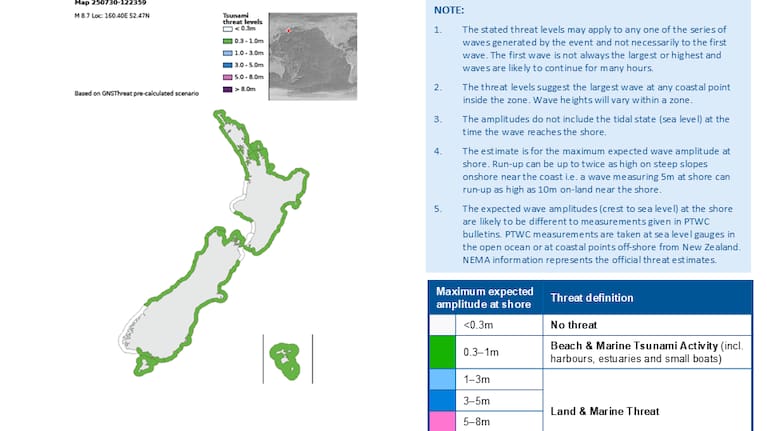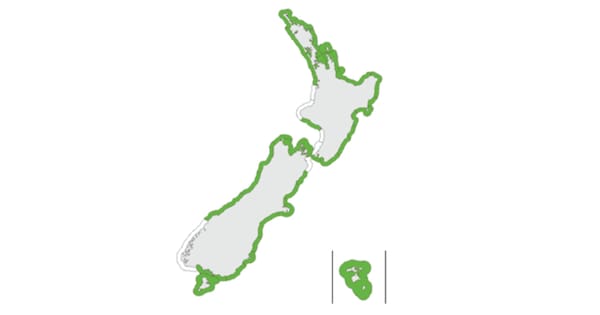New Zealand can expect “strong and unusual currents” and “unpredictable surges” at the shore following a powerful 8.7 magnitude earthquake off Russia’s far east this morning, the National Emergency Management Agency (NEMA) says.
The US Geological Survey said the quake occurred at 11.25am near the Kamchatka Peninsula and registered a preliminary magnitude of 8.0, later upgraded to 8.7. It is the largest earthquake to occur anywhere on the planet since 2021 and the first to be measured at a magnitude higher than 8 this year.
Russia, Japan, and the US states of Hawai’i and Alaska were under tsunami warnings.
NEMA earlier said there was no tsunami threat, but reassessed after the earthquake’s magnitude was upgraded.
“Strong currents and surges can injure and drown people. There is a danger to swimmers, surfers, people fishing, and anyone in or near the water close to shore,” NEMA said.
“People in or near the sea in the following areas should move out of the water, off beaches and shore areas and away from harbours, marinas, rivers and estuaries.”
Coastal inundation was not expected as a result of this event, NEMA added.
“Strong and unusual currents and unpredictable surges will continue for several hours and the threat must be regarded as real until this advisory is cancelled.”

Areas under threat
On the west coast of the North Island, impacts would be felt from Cape Reinga to Raglan, including the west coast of Auckland and Manukau Harbour, and from Hawera to Whanganui.
On the east and south coasts of the North Island, areas from Cape Reinga to Makara, including Whangārei, Great Barrier Island, the east coast of Auckland, Waiheke Island, Waitematā Harbour, Tauranga, Whakatāne, Ōpōtiki, Gisborne, Napier, Lake Ferry, the Wellington south coast and Wellington Harbour.
South Island’s west coast would be impacted from Farewell Spit to Milford Sound, including Westport, Greymouth and Hokitika.
At the top of the South Island, from Farewell Spit to Port Underwood, including Nelson, Picton and the Marlborough Sounds.
On the east and south coasts of the South Island from the Clarence River to Puysegur Point, including Kaikōura, Christchurch, Banks Peninsula, Timaru, Ōamaru, Dunedin, the Otago Peninsula and Invercargill.
Stewart Island and Chatham Islands were also impacted.
Warnings for Russia, Japan, Hawai’i and Alaska
Japan’s meteorological agency issued an advisory for a tsunami of up to 3 metres across the Pacific coast of Japan, possibly starting to arrive along the northern Japanese coasts in less than half an hour after the alert.
A tsunami warning also was extended to the US state of Hawaii, with the National Weather Service’s Pacific Tsunami Warning Centre saying a tsunami from the quake had been generated that could cause damage along the coastlines of all the Hawaiian islands.
“Urgent action should be taken to protect lives and property,” the warning stated. The first waves were expected around 7pm local time.
Russia’s Tass news agency reported from the biggest city nearby, Petropavlovsk-Kamchatsky, that many people ran out into the street without shoes or outerwear. Cabinets toppled inside homes, mirrors were broken, cars swayed in the street and balconies on buildings shook noticeably.
Tass also reported power outages and mobile phone service failures in the capital of the Kamchatka region.
The National Tsunami Warning Centre, based in Alaska, issued a tsunami warning for parts of the Alaska Aleutian Islands, and a watch for portions of the West Coast, including California, Oregon, and Washington, and Hawaii.
The advisory also includes a vast swath of Alaska’s coast line, including parts of the panhandle.
The Japanese government said it set up a taskforce for information gathering and response in case of any emergency. A University of Tokyo seismologist Shinichi Sakai told NHK that a distant earthquake could cause a tsunami that affects Japan if its epicenter is shallow.
Japan, part of the area known as the Pacific ring of fire, is one of the world’s most quake-prone country.
Earlier in July, five powerful quakes — the largest with a magnitude of 7.4 — struck in the sea near Kamchatka. The largest quake was at a depth of 20 kilometres and was 144 kilometres east of the city of Petropavlovsk-Kamchatsky, which has a population of 180,000.
On November 4, 1952, a magnitude 9.0 quake in Kamchatka caused damage but no reported deaths despite setting off 9.1m waves in Hawaii.
